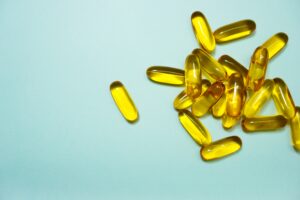What are Omega-3s?
Omega-3s are classed as essential fatty acids, meaning our bodies need them but don’t synthesise them, so we must obtain them through our food. But how much do we need, and how can we tell if we a lack of omega-3?
Before we answer these questions, let’s be clear what we’re talking about. Three omega-3 fatty acids are of particular importance to human physiology, namely:
Alpha-linolenic acid: ALA is essential to the normal growth and health of our body’s cells, but unlike EPA and DHA (see below), it is not known for providing significant cardiovascular benefits. Our bodies convert small amounts of ALA into EPA and DHA, but the process is inefficient.
The US Institute of Medicine has set an Adequate Intake value for ALA at 1.6 g/day for men and 1.1 g/day for women. Good dietary sources include seeds (flax, hemp and chia, for example), walnuts, soybeans, spinach, Brussels sprouts, and common vegetable oils. Flaxseeds are particularly good because, unlike most other ALA sources, they contain little linoleic acid, an omega-6 fatty acid that most people’s diets already contain in excess.
Eicosapentaenoic acid and docosahexaenoic acid: Both EPA and DHA are critical to our neurological and cardiovascular health, while DHA also plays an important role in the maintenance and development of our immune system.
We obtain them primarily by consuming animal fats, either in our meals or as dietary supplements. Recommendations for daily intakes vary from one health authority to the next, but not widely. For example, the US Food and Drug Administration advises that adults can safely consume up to 3 g/day of EPA + DHA, with no more than 2 g coming from supplements (Source). The American Heart Association recommends we consume oily fish twice a week, while the World Health Organization recommends one or two servings a week of fish (equivalent to 200 to 500 mg/day of EPA + DHA).

Great sources of EPA and DHA
- Oily fish like salmon, herring, mackerel, anchovies and sardines. Wild fish generally have higher levels of omega-3s than farmed fish, unless the farmed fish have their diet supplemented, usually with fish oil (Source).
- Krill oil. As a source of EPA and DHA, these tiny crustaceans are comparable to oily fish (Source).
- Chicken eggs and meat. These are good sources of omega-3s if their feed includes greens and insects, or supplements like fish oil, flax or canola seeds, green algae, and seaweed (Source).
- Grass-fed beef. All beef is a good source of EPA and DHA, but the best comes from cattle that have been fed only grass. Kangaroo meat is also a rich source (Source), though not widely available outside Australia.

Omega 3 Deficiency Symptoms
- A variety of health problems can arise from an omega-3 deficiency, but they are easily overlooked. Sometimes the symptoms may not even be noticed by the sufferer, or they may be mistaken for signs of other deficiencies, such as of calcium or iron.
- But before worrying unduly, ask yourself whether you’re a good candidate for being deficient. For example, if you regularly start the day with muesli (lots of seeds and nuts), and enjoy your tuna or salmon twice a week, and a grass-fed steak at the weekend, you’re probably just fine. But if you never eat fish, or you’re a vegetarian, or your diet is just very low in fat, consider changing your diet or taking an omega-3 supplement.
- Here are the more obvious symptoms of a possible omega-3 deficiency:
- Cardiovascular concerns. Do you or your doctor suspect you may have heart problems? A large body of research now indicates that omega-3s can help with existing conditions, and make it less likely problems will develop in the future.
- Skin, hair and nail problems. Omega-3s play key roles in building cell walls, and a deficiency can cause a variety of problems, including: dry skin or skin rashes, brittle hair, dandruff, and thin nails that peel and crack.
- Insomnia and associated fatigue. Difficulty sleeping, and the fatigue that almost always comes with it, can be hard to diagnose because so many factors can be responsible. But an omega-3 deficiency may be the culprit, and boosting your intake may help improve the amount and quality of sleep you get.
- Poor concentration and attentiveness. An omega-3 deficiency can contribute to difficulty with memory and focus, and also cause irritability and anxiety. If you’re short-tempered all the time but can’t pinpoint a reason, you may be lacking in omega-3s.
- Painful joints and leg cramps. EPA and DHA have excellent anti-inflammatory properties, helping prevent and reduce swelling and inflammation in the joints and throughout the body. Since joint pain is such a common problem as we age, consider boosting your omega-3 intake even if you don’t have problems yet. Prevention is better than cure.
- Allergy symptoms. Common symptoms of allergies can be exacerbated by an omega-3 deficiency. These include asthma, eczema and hives.
- Menstrual problems. Women who experience prolonged or heavy periods, especially accompanied by clotting, may find upping their intake of omega-3s relieves the problem. Many studies have been conducted on natural ways to relieve menstrual problems, including primary dysmenorrhea – pain that starts a few hours before or at the onset of menstruation, and that can be debilitating. A study published in Gynecological Endocrinology in 2018 demonstrated that vitamin E and fish oil, taken in combination or separately, relieved dysmenorrhea (Source).
- Ear wax and impaired hearing. A certain amount of ear wax is totally normal, but if it starts clogging your ears and impairing your hearing, an omega-3 deficiency may be the cause. One study at the University of Sydney (Source) found a significant reduction in the likelihood of hearing loss in elderly people who ate at least two servings of fish per week.

Sources:
- http://www.fao.org/in-action/globefish/fishery-information/resource-detail/en/c/338773/
- https://ods.od.nih.gov/factsheets/Omega3FattyAcids-HealthProfessional/
- https://www.ncbi.nlm.nih.gov/pmc/articles/PMC3024511/
- https://cdnsciencepub.com/doi/10.4141/CJAS07081
- https://web.archive.org/web/20090301215435/http://www.macromeats-gourmetgame.com.au/Nutrition/AmazingNutritionFacts.aspx
- https://pubmed.ncbi.nlm.nih.gov/29542390/



